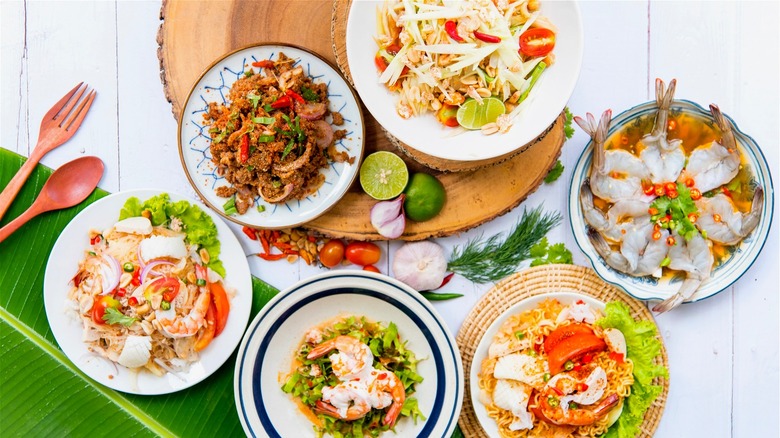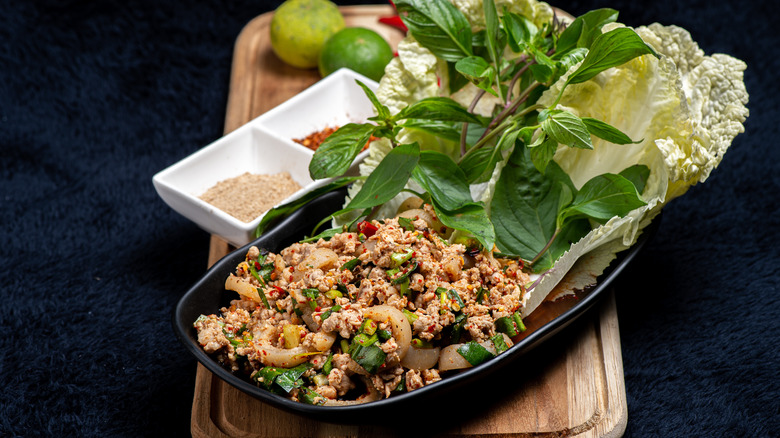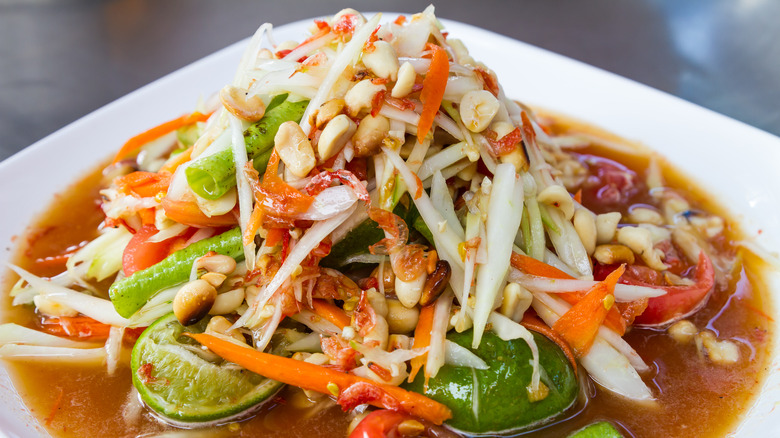What Makes Thai Salads Unique?
In Thailand, salads are an essential component of Thai meals. Rather than being a healthy item thrown onto a menu or a side to get your veggies in, salads are crucial to Thai cuisine, and they go far beyond the lettuce-laden and leafy green dishes that might come to some people's minds when you imagine a salad. A well-balanced Thai meal includes a mix of meat and/or fish, vegetables, and usually a noodle dish; Thai salads aren't just relegated to the vegetable category, but instead, can be noodle- or meat-based too (via The Spruce Eats).
Serious Eats explains that most Thai salads are actually protein-heavy complemented by a few fresh, vegetable or herb ingredients. Given this, these salads are not served as a "healthy side" but instead usually as a protein-heavy yet fresh element to balance out the meal. Having a general understanding of the different types of Thai salads and their unique components gives insights into how important they are to the cuisine. So, let's dive into it.
Different types of Thai salads
In Thai cuisine, there are four general salad categories (per Serious Eats), which are classified by culinary technique: yam, tam, laab, and pla. Understanding the variety of salads possible in Thailand shows us how versatile they are. In addition, given Thailand's connection to Buddhism, which discourages the cooking of whole animals, most meats and fish are chopped, sliced, or shredded, instead of consumed in whole chunks (per Spruce This philosophy could be part of the reason why Thailand's protein-heavy salads came to be (via Taste of Thailand).
Serious Eats explains that yam, which means "mix," are generally protein-heavy salads that are balanced out by fresh herbs and crunchy vegetables. Tam salads, on the other hand, are made by pounding the ingredients together using a mortar and pestle and typically focus on fresh fruits and vegetables as seen in the popular green papaya salad. A laab salad is typically made with ground or finely chopped meats tossed with a flavorful, yet fresh, dressing. Lastly, a pla salad can be somewhat compared to a ceviche, where lightly cooked proteins, such as shrimp or beef, cook further in the acidity of a dressing.
The four essential ingredients
As different as these various types of Thai salads can be, there are unique flavors that tie them all together. The use of fish sauce, lime juice, sugar, and chili is important to Thai cuisine in general, and this absolutely holds true for their salads. Regardless of the type of salad made, it is usually tossed with a dressing made from some combination of these four ingredients (via Serious Eats). It is important to note, however, that not all four are always necessary.
According to Masterclass, Thai food tends to balance sweetness with acid and heat so it makes perfect sense why limes, sugar, and chilis are so essential to the cuisine, even their salads. The addition of fish sauce brings in the desired umami or the "fifth taste." Fish sauce, which is made from salted and fermented fish, has been perfected to become salty, sweet, and savory all at once (via Masterclass). You'll find these ingredients prevalent throughout Thai cuisine, and they are part of what makes these salads uniquely Thai.
Curious about giving Thai salads a try? Try this Thai Smashed Cucumber Salad or Yam Samun Phrai at home!


